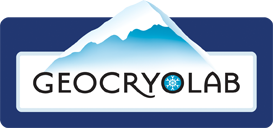Heat Advection in the Active Layer of Permafrost: Physical Modelling to Quantify the Impact of Subsurface Flow on Soil Thawing.
The 7th Canadian Permafrost Conference and 68th Canadian Geotechnical Conference (GEOQuébec2015) took place in Quebec City last September. On Sept. 23rd during the “Physical and Numerical Modelling in Cold Regions” session chaired by Marc Lebeau, I presented a portion of the laboratory research I have been conducting during this past year at the Geocryolab. My
read more
Incidence of Late Pleistocene-Holocene Climate on the Concurrent Landscape and Permafrost Development of the Beaver Creek Region, Southwestern Yukon, Canada
For the 7th Canadian Permafrost Conference and 68th Canadian Geotechnical Conference (GEOQuébec2015), held in Quebec City last month (September 20-23), I presented a geomorphological model of the Beaver Creek moraine, inherited from the Mirror Creek glaciation. This model outlines five development stages of the landscape and permafrost interpreted from five cryostratigraphic units found in numerous
read more
Impact of land cover disturbance on permafrost landscapes: Case Studies from Yukon communities
As part of the 7th Canadian Permafrost Conference and the 68th Canadian Geotechnical Conference (GEOQuébec 2015) held in Quebec City last September, Louis-Phillippe Roy (Yukon College) presented three case studies from our work done in Yukon communities in recent years. We found that the complete removal of vegetation cover for agriculture or mining activities had
read more
Lake bottom imagery: a simple, fast and inexpensive method for surveying shallow freshwater ecosystems of permafrost regions
During the 7th Canadian Permafrost Conference and 68th Canadian Geotechnical Conference (GEOQuébec2015), held in Quebec City last month (September 20-23), I presented a novel strategy of surveying and sampling lake sediments. This method integrates modern and readily available lake bottom imagery tools (GPS-sonar and waterproof camera), and allows us to quickly map lake basins and
read more

Contrasting patterns of thermo-erosion gullies formed in syngenetic ice wedge polygonal terrains on Bylot Island, eastern Canadian Arctic: case studies from three different sedimentary environments
During the GeoQuebec2015 conference in Quebec city, I had to chance to present my bachelor thesis. It was my first time in a national conference and I was very happy and apprehensive to break the ice – no pun intended! The presentation was set on Monday 21st of September (15:45) during a session chaired by
read more
C-Degel Project : web page now online
The C-Degel project summary and team presentation webpage is now online: click here to visit the page!
L’avenir de la recherche en pergélisol selon les jeunes chercheurs, dans ‘The Cryosphere’
Ce papier récemment publié dans le journal The Cryosphere de EGU intitulé ‘Brief Communication: Future avenues for permafrost science from the perspective of early career researchers‘ propose des pistes de réflexion sur l’avenir de la recherche en pergélisol. Les auteurs de l’article dont Julie Malenfant Lepage, Frédéric Bouchard et Michel Paquette ont colligé les idées et commentaires émis
read more
Julie Malenfant-Lepage au Canal Savoir : Quoi de neuf chercheurs ?
Nouvelle série télé au Canal Savoir : Quoi de neuf chercheurs? : Cette coproduction originale avec les Fonds de recherche du Québec représente une occasion en or de découvrir les résultats d’une multitude de travaux menés dans les centres de recherche universitaire soutenus par les trois Fonds (Nature et technologies, Santé, Société et culture) et
read more
Surface water flow on a physical model of permafrost filmed with an Infrared camera
The test was made on a wooden cell filled with saturated sand and frozen at -20°C. After freezing, the cell was brought to a cold room with an ambient temperature of 5°C. The water flow was 0.5 cm3/h and the temperature was 15°C. The film was made with using an Infrared camera. While the temperature
read more
Le départ de Ward Hunt Island
7 août 2015, Resolute Bay Le terrain touche déjà à sa fin. Notre sortie de WHI était prévue pour le 8 sur le planning de PCSP. Mais de la feuille de papier à la réalité du terrain, il y a un monde…surtout dans l’Arctique. Lors de l’appel radio du 6 août au matin avec Resolute
read more
Old Crow : risk assessment
The Geocryolab is working since 3 years in collaboration with the Yukon Research Center for an exciting project assessing environmental hazards related to climate changes for Yukon communities. One of its members (Katerine Grandmont) begins a 10 days fieldtrip in the small community of Old Crow, north of the Arctic Circle, to collect data that
read more
Nunavummiut, Parks Canada and Science
The 22nd of June 2015, Bylot Island, Nunavut. Around mid June 2015, we heard from our bi-daily radio communication with the outside world that visitors were interested in visiting Goose Camp. Parks Canada’s rangers and manager (Sirmilik Park) visiting us is a regular event, we know each other by name, appearance or project (yeah that guy
read more
Michel Paquette, back from Cape Bounty
Geocryolab has now set foot on the western Canadian High Arctic! Back from Cape Bounty Arctic Watershed Observatory, on Melville Island, Michel Paquette just inaugurated the collaborative effort between host researchers from Queen’s University and the Geocryolab. The short stay allowed the discovery of an at least 2m thick layer of buried massive ice near
read more
